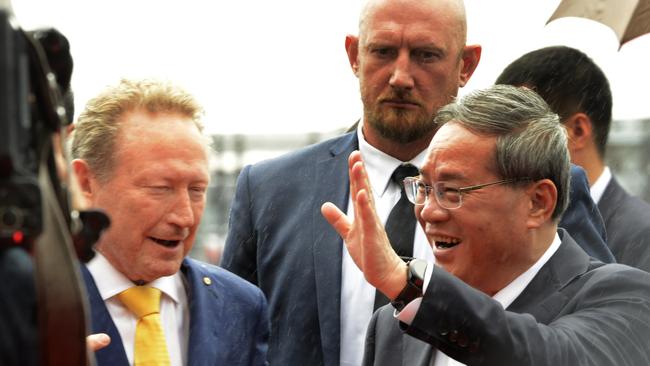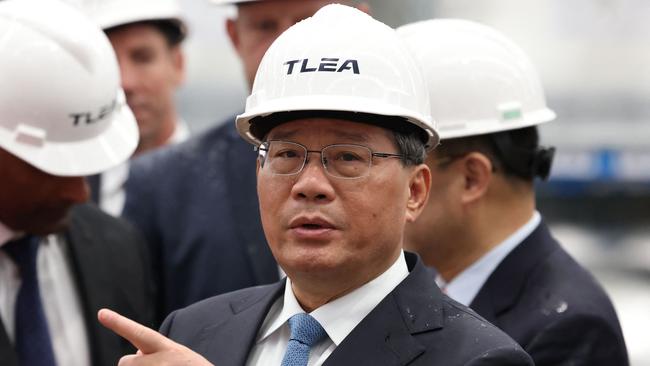Renewables at centre of Australia-China business roundtable
The two major miners have flagged plans to work more closely with China as part of their energy transition plans as business and political leaders met for their first roundtable since 2017.

Two of the nation’s biggest mining companies have flagged plans to work more closely with China as part of their energy transition plans.
Business leaders from 14 Australian companies on Tuesday met with Chinese Premier Li Qiang, Prime Minister Anthony Albanese and their counterparts from 14 major Chinese companies in the first Australia-China CEO Roundtable since 2017.
There had previously been six such roundtables, but the events had dropped away in recent years as relations between the two nations soured.
Despite the tensions, and China’s imposition of trade barriers on a host of industries including coal, barley, wine and lobster, trade between the two nations has continued to grow and hit $327 billion in 2023 – or more than a quarter of Australia’s total goods and services trade.
Each of the business leaders had precisely three minutes to speak during the event, with most of the executives focusing on the potential opportunity to grow trade with China.
Mr Li dedicated much of his visit to Western Australia to exploring the potential around energy transition technologies, visiting a lithium processing plant in Kwinana in the morning before heading to Fortescue’s research and development facility to inspect the miner’s prototype hydrogen haul trucks and battery-powered locomotives.

After the roundtable, BHP chief financial officer Vandita Pant said the company was very positive about the opportunities in that space.
“China has a critical leadership role in the transition to a global clean energy future. We’re working closely with our customers, suppliers and partners in China to help in this effort,” Ms Pant said.
“For the transition to succeed, companies and nations must work collaboratively together.”
Fortescue chairman Andrew Forrest similarly talked up the potential for a supply chain between Australia and China that would eliminate hundreds of millions of tonnes of emissions while maintaining China’s position as the dominant global steel producer.
“Working with Chinese partners will help give Fortescue a competitive advantage to achieve our Real Zero decarbonisation targets and has the potential to deliver massive economic opportunities in both countries,” Dr Forrest said.
The billionaire said he had seen first hand the inroads China was making in renewables.

“Green iron metal will help defeat the challenging pollution and smog issues surrounding some of the world’s biggest cities. It will bring down global emissions dramatically and help prevent the world from seeing a worsening of the lethal humid heat belts that are already driving losses in human life, livestock and productivity in India, the USA, China, South America and Africa,” he said.
Qube Holdings managing director Paul Digney said the importance of strong and resilient supply chains in the economic success of both nations was acknowledged during the event.
“I also appreciated the focus on the potential for Australian and Chinese businesses to collaborate on the challenges associated with decarbonisation,” he said.
“The technology and innovation emerging from that market, particularly around electrification of heavy equipment and machinery, is a real area of potential growth and co-operation from Qube’s perspective.“
GrainCorp CEO Robert Spurway said he was optimistic about the future growth prospects of both nations in the wake of the roundtable.
“During the meeting, we discussed the opportunity to further align phytosanitary requirements between the countries, and to streamline trade with better use of digital and electronic shipping documentation,” he said.
“Agricultural trade is critical for China’s food security and nutrition needs, and of course a vital economic contribution from regional and rural communities in Australia.
Mark Whelan, Group Executive Institutional at ANZ, said the event was an opportunity for Chinese and Australian chief executives to discuss how they can work together on the energy transition.
“The forum allowed us to share ideas and insights on the opportunities ahead of us, while highlighting the importance of a strong relationship and continued collaboration,” he said.


To join the conversation, please log in. Don't have an account? Register
Join the conversation, you are commenting as Logout